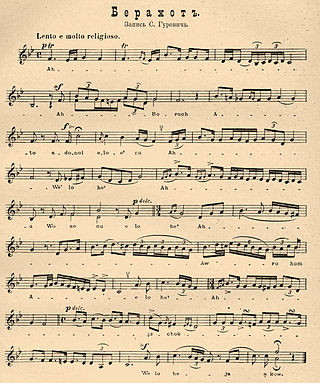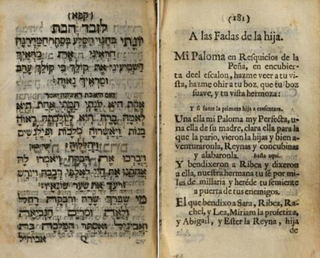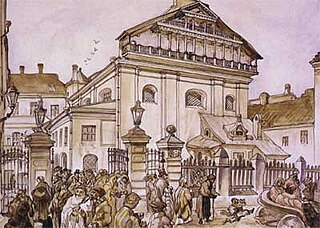
A siddur is a Jewish prayer book containing a set order of daily prayers. The word siddur comes from the Hebrew root ס־ד־ר, meaning 'order.'

A synagogue, also called a shul or a temple, is a place of worship for Jews and Samaritans. It has a place for prayer where Jews attend religious services or special ceremonies such as weddings, b'nai mitzvah, choir performances, and children's plays. They also have rooms for study, social halls, administrative and charitable offices, classrooms for religious and Hebrew studies, and many places to sit and congregate. They often display commemorative, historic, or modern artwork alongside items of Jewish historical significance or history about the synagogue itself.

The Amidah, also called the Shemoneh Esreh, is the central prayer of the Jewish liturgy. Observant Jews recite the Amidah at each of three daily prayer services in a typical weekday: morning (Shacharit), afternoon (Mincha), and evening (Ma'ariv). On Shabbat, Rosh Chodesh, and Jewish festivals, a fourth Amidah (Mussaf) is recited after the morning Torah reading, and once per year, a fifth Amidah (Ne'ilah) is recited, around sunset, on Yom Kippur. Due to the importance of the Amidah, in rabbinic literature, it is simply called "hatefila". According to legend, the prayer was composed by the rabbis of the Anshei Knesset HaGedolah. Accordingly, in Judaism, to recite the Amidah is a mitzvah de-rabbanan, i. e., a commandment of rabbinic origin.

Isaac ben Solomon Luria Ashkenazi, commonly known in Jewish religious circles as Ha'ari, Ha'ari Hakadosh or Arizal, was a leading rabbi and Jewish mystic in the community of Safed in the Galilee region of Ottoman Syria, now Israel. He is considered the father of contemporary Kabbalah, his teachings being referred to as Lurianic Kabbalah.

Sephardic law and customs are the law and customs of Judaism which are practiced by Sephardim or Sephardic Jews ; the descendants of the historic Jewish community of the Iberian Peninsula, what is now Spain and Portugal. Many definitions of "Sephardic" also include Mizrahi Jews, most of whom follow the same traditions of worship as those which are followed by Sephardic Jews. The Sephardi Rite is not a denomination nor is it a movement like Orthodox Judaism, Reform Judaism, and other Ashkenazi Rite worship traditions. Thus, Sephardim comprise a community with distinct cultural, juridical and philosophical traditions.

Zeved habat or Simchat Bat is the Jewish naming ceremony for newborn girls. The details of the celebration varies somewhat by Jewish community and will typically feature the recitation of specific biblical verses and a prayer to announce the name of the newborn child.
Zemirot or Z'miros are Jewish hymns, usually sung in the Hebrew or Aramaic languages, but sometimes also in Yiddish or Ladino during Shabbat and to some extent the Jewish holidays. As a result of centuries of custom, albeit with some communal variations, each of the zemirot has become associated with one of the three obligatory meals of Shabbat: the Friday evening meal, the Saturday day meal, and the third Sabbath meal that typically starts just before sundown on Saturday afternoon. In some editions of the Jewish prayerbook (siddur), the words to these hymns are printed after the (kiddush) for each meal.
Lekha Dodi is a Hebrew-language Jewish liturgical song recited Friday at dusk, usually at sundown, in synagogue to welcome the Sabbath prior to the evening services. It is part of Kabbalat Shabbat.
In Judaism, Nusach is the exact text of a prayer service; sometimes the English word "rite" is used to refer to the same thing. Nusakh means "formulate" or "wording".

Adon Olam is a hymn in the Jewish liturgy. It has been a regular part of the daily and Shabbat (Sabbath) liturgy since the 15th century.

Vayakhel, Wayyaqhel, VaYakhel, Va-Yakhel, Vayak'hel, Vayak'heil, or Vayaqhel is the 22nd weekly Torah portion in the weekly Torah portion and the 10th of the Book of Exodus. The parashah tells of the making of the Tabernacle and its sacred vessels. It constitutes Exodus 35:1–38:20. The parashah is made up of 6181 Hebrew letters, 1,558 Hebrew words, 122 verses, and 211 lines in a Torah scroll.
Chol HaMoed, a Hebrew phrase meaning "mundane of the festival", refers to the intermediate days of Passover and Sukkot. As the name implies, these days mix features of chol (mundane) and moed (festival).
Pizmonim are traditional Jewish songs and melodies sung with the intention of praising God as well as learning certain aspects of traditional religious teachings. They are sung throughout religious rituals and festivities such as prayers, circumcisions, bar mitzvahs, weddings and other ceremonies.
The baqashot are a collection of supplications, songs, and prayers that have been sung by the Sephardic Syrian, Moroccan, and Turkish Jewish communities for centuries each week on Shabbat mornings from the early hours of the morning until dawn. They are usually recited during the weeks of winter, from the Jewish festival of Sukkot through Purim, when the nights are much longer. The baqashot services can last for three to four hours. The Ades Synagogue in Jerusalem is the center of the Syrian practice today, and communities in Ashdod and Montreal are the center of the Moroccan practice.

The Four Sephardic Synagogues are a complex of four adjoining synagogues located in the Jewish Quarter of the Old City of Jerusalem. The four synagogues include the Eliahu Ha'navi Synagogue, the Yochanan ben Zakai Synagogue, the Istanbuli Synagogue, and the Emtsai Synagogue formed from a courtyard amidst the synagogues that was roofed in the mid-18th century.

The Great Synagogue of Vilnius, which once stood at the end of Jewish Street (I-2), Vilnius, Lithuania, was built between 1630 and 1633 after permission was granted to construct a synagogue from stone. Standing on the spot of an existing synagogue built in 1572, the site had first been used to house a Jewish house of prayer in 1440. Damaged in World War II, it was demolished in 1955–1957 and replaced by a kindergarten and a primary school.
Nusach Sefard, Nusach Sepharad, or Nusach Sfard is the name for various forms of the Jewish siddurim, designed to reconcile Ashkenazi customs with the kabbalistic customs of Isaac Luria. To this end it has incorporated the wording of Nusach Edot haMizrach, the prayer book of Sephardi Jews, into certain prayers. Nusach Sefard is used nearly universally by Hasidim, as well as by some other Ashkenazi Jews but has not gained significant acceptance by Sephardi Jews. Some Hasidic dynasties use their own version of the Nusach Sefard siddur, sometimes with notable divergence between different versions.
This article describes the principal types of religious Jewish music from the days of the Temple to modern times.

The Ari Synagogue is situated on Or HaHaim Street in the Jewish Quarter of the Old City of Jerusalem. It is located on the ground floor of a building which also houses the Ohr ha-Chaim Synagogue and Old Yishuv Court Museum. It is named after Rabbi Isaac Luria, (1534–1572), who was known as the Ari, an acronym for haEloqi Rabbeinu Yitzhak. He was a great kabbalist who founded a new school in Kabbalistic thought, known as the "System of the Ari" or "Lurianic kabbalah".
The Old Yishuv were the Jewish communities of the region of Palestine during the Ottoman period, up to the onset of Zionist aliyah and the consolidation of the New Yishuv by the end of World War I. In the late 19th century, the Old Yishuv comprised 0.3% of the world's Jews, representing 2–5% of the population of the Palestine region.












